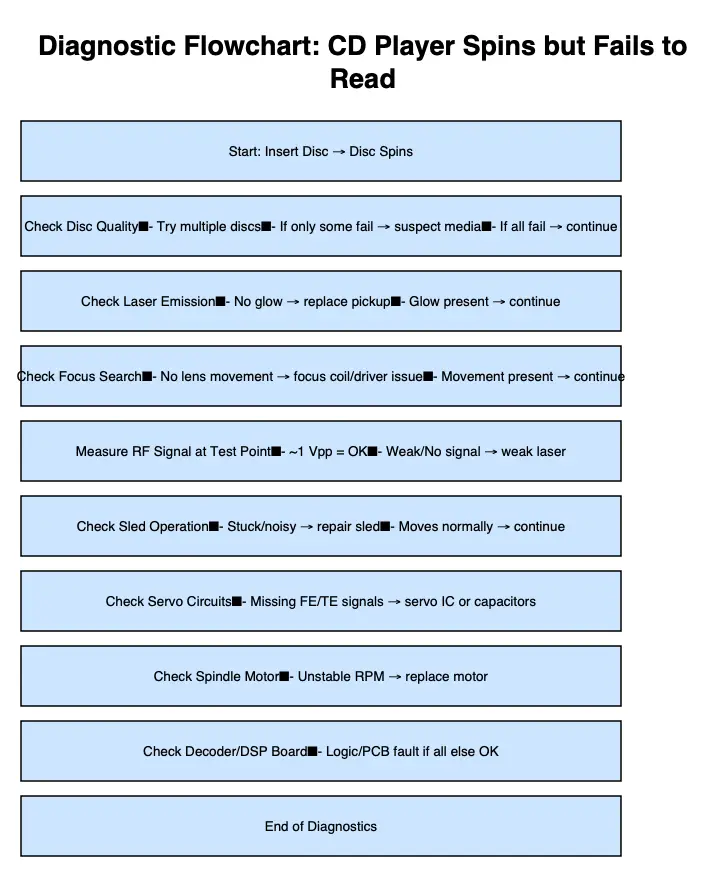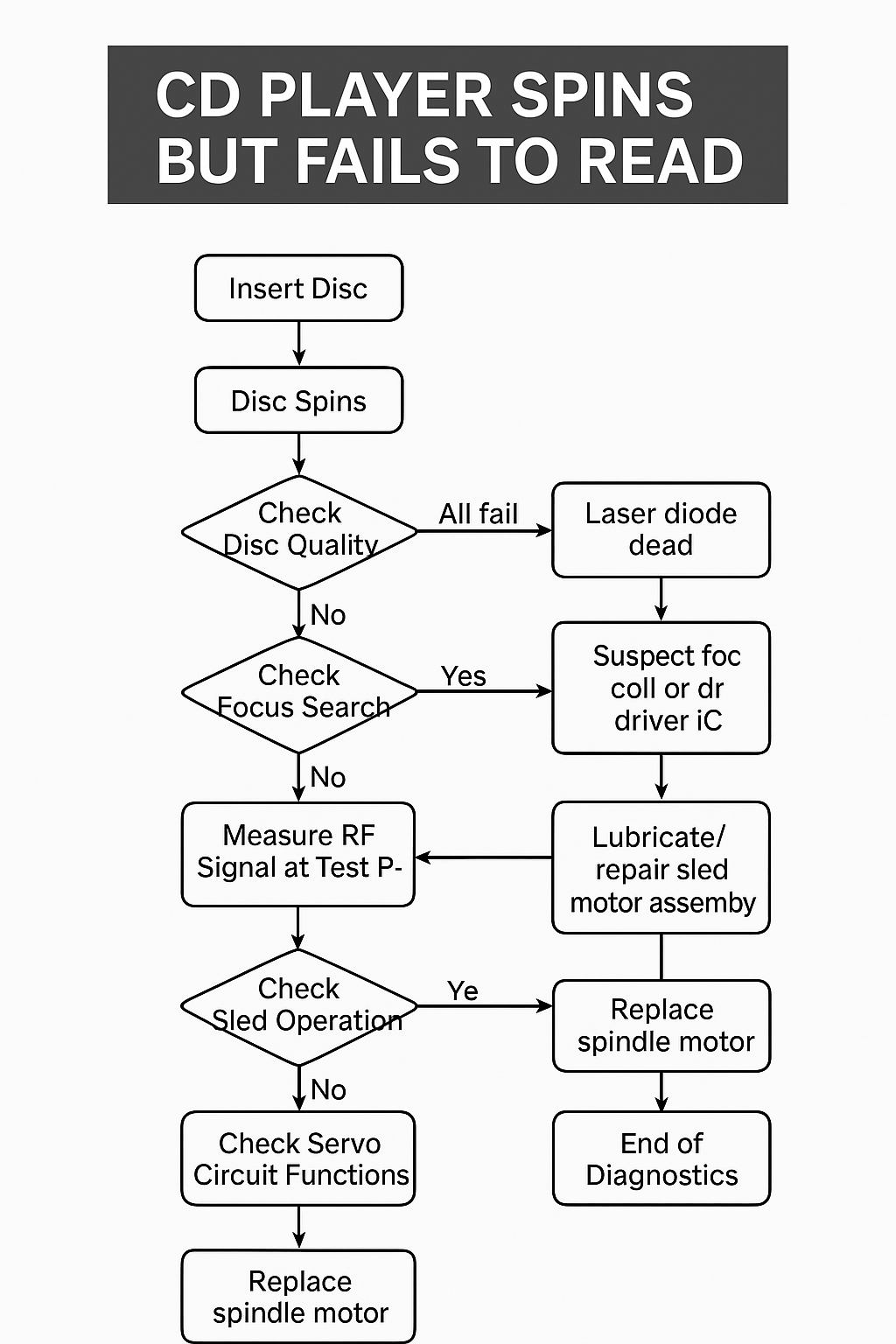When a CD player spins but fails to read discs, the spindle motor is operational, but the optical pickup system or servo control circuits are not functioning correctly. This issue is common in consumer audio decks, portable CD players, and hi-fi units, and typically points to problems in the laser pickup assembly, focus/tracking servos, or related mechanics.
Functional Overview
A CD player operates through the coordinated function of:
-
Spindle Motor – Rotates the disc at variable speeds (200–500 RPM).
-
Optical Pickup (Laser Diode + Photodiodes + Objective Lens) – Reads pits and lands on the disc.
-
Sled Motor and Gear Mechanism – Moves the pickup radially across the disc.
-
Servo Circuits – Handle focus, tracking, and spindle speed regulation.
-
Decoder/DSP IC – Converts EFM (Eight-to-Fourteen Modulation) signals into audio data.
If the disc spins but no TOC (Table of Contents) is read, the spindle subsystem is intact, but the optical or servo loop is failing.
Common Technical Causes
1. Contaminated or Obstructed Objective Lens
-
Effect: The focus servo cannot achieve lock; disc continues spinning with repeated retries.
-
Diagnosis: Look for dust, haze, or residue on the lens. The pickup may make repeated “hunting” motions.
-
Fix: Clean lens with 90%+ isopropyl alcohol and a lint-free swab. Avoid excess fluid that can wick into the coil suspension.
2. Laser Diode Weakness or Failure
-
Effect: Reduced optical output leads to weak or absent RF signal (expected ~1 Vpp from RF test point).
-
Diagnosis: Connect oscilloscope to RF test point on the mainboard while attempting playback. A weak or noisy signal (<200 mVpp) indicates diode degradation.
-
Fix: Replace the pickup assembly (in most cases, individual diode replacement is impractical).
3. Objective Lens Actuator Failure
-
Effect: No focus gain despite laser emission. The lens may not move, or movement is erratic.
-
Diagnosis: Observe lens under operation; if it fails to “bob” up and down, the focus coil or driver IC may be open or shorted.
-
Fix: Check coil resistance (typically 8–16 Ω). Replace optical pickup if open.
4. Sled Motor or Gear Malfunction
-
Effect: Lens cannot traverse the disc radius, so TOC cannot be read. Spindle spins continuously without track location.
-
Diagnosis: Audible clicking, or sled stuck at inner/outer track. Test sled motor with 3–5 V DC supply. Inspect gears and lubrication.
-
Fix: Clean and lubricate rails, replace motor or worn gears.
5. Servo Circuit Faults
-
Focus Servo Failure – Player cannot lock on track; spindle ramps erratically.
-
Tracking Servo Failure – Intermittent reading or skipping.
-
Diagnosis: Use service manual to enter test mode. Check waveforms at focus error and tracking error test points.
-
Fix: Replace servo driver ICs (e.g., BA6297, AN8735, etc.), check electrolytic capacitors in servo supply rails.
6. Spindle Motor Wear
-
Effect: Motor spins but cannot maintain stable CLV (Constant Linear Velocity). RF signal fluctuates or drops.
-
Diagnosis: Monitor spindle motor voltage during playback. Excessive noise or inconsistent RPM suggests worn bearings/commutator.
-
Fix: Replace spindle motor (often bundled with optical pickup in modern drives).
Diagnostic Procedure (Step-by-Step)
-
Verify Disc Integrity – Rule out scratched or nonstandard media.
-
Check Laser Emission – In a dark environment, a faint red glow should be visible (never stare directly).
-
Test Focus Action – Observe lens bobbing at power-on. If absent, suspect focus coil or driver IC.
-
Measure RF Output – Attach oscilloscope probe to RF test point; expect ~1 Vpp clean eye pattern when disc is readable.
-
Evaluate Servo Signals – Consult service manual for focus error (FE), tracking error (TE), and sled motor drive waveforms.
-
Isolate Mechanical Issues – Inspect sled rails, gears, and motor function.
Repair Considerations
-
Cleaning: Always start with optical lens and disc cleaning.
-
Component Replacement: Most modern CD players use integrated pickup/motor assemblies (e.g., KSS-213, SF-P101). Replacement is often more economical than repair.
-
Alignment: Some units require servo alignment (bias, gain, tracking offset). Use service manual and oscilloscope for calibration.
-
Economics: In low-cost consumer units, pickup replacement may exceed the unit’s value. High-end players justify repair.
Conclusion
A CD player that spins but does not read discs is almost always suffering from a laser pickup failure, servo issue, or sled malfunction. Using an oscilloscope and service documentation is critical for pinpointing the defect. While cleaning may restore operation in mild cases, many failures require pickup or motor replacement.


